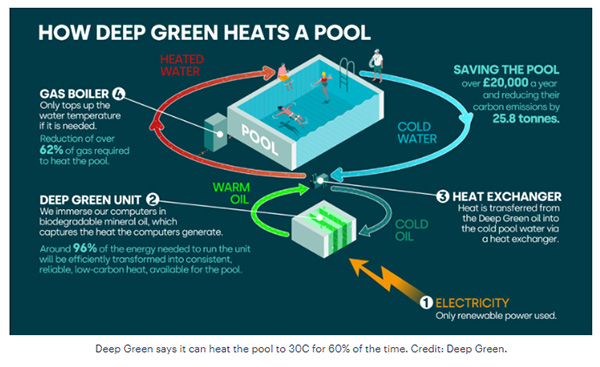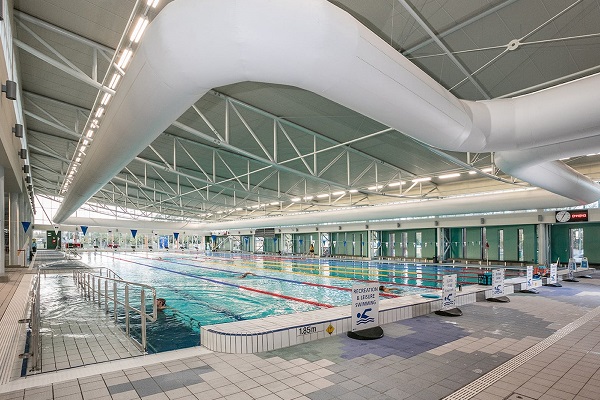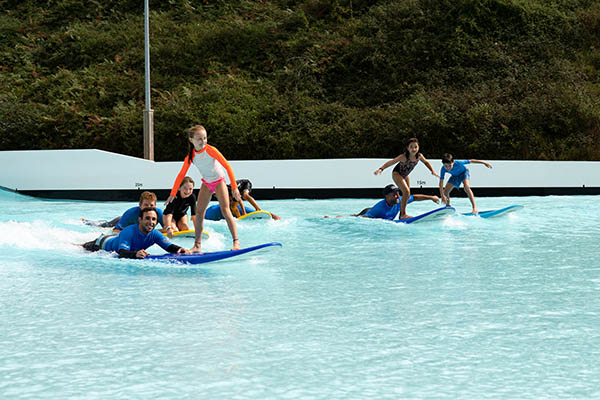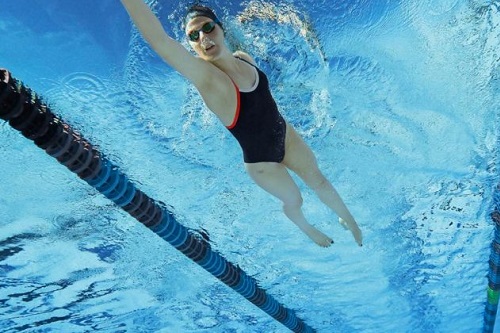Aiming to provide a solution for swimming pools's rising energy costs, the Exmouth Leisure Centre in the UK county of Devon is trialling an innovation that is recycling heat generated by a data processing centre as a way of heating its pools.
Deep Green, a data centre heat recapturing company, is piloting using the large amount of energy produced by a data centre to heat the Exmouth Leisure Centre’s 25 metre pool.
The innovation has seen a data centre computer - the size of a washing machine - located at the Leisure Centre and surrounded by oil to capture the heat. This is generating enough energy to heat the pool to about 30 degrees Celsius 60% of the time, saving Exmouth Leisure Centre thousands of pounds.
In return, Deep Green gets free cooling which provides it with a significant competitive edge over traditional data centres.
Explaining that the idea could go well beyond providing energy for swimming pools, Mark Bjornsgaard, Chief Executive of technology startup Deep Green, advised “if just 1% of the data centre demand in the UK operated on our servers, we could deploy in every public pool in the country."
Processing data generates a lot of wasted heat, which Deep Green’s scheme aims to repurpose to provide free heat for energy-intensive organisations such as aquaitc facilities, which, globally, have been affected by soaring bills in the cost of living crisis, with many having to close or cut hours.
This prompted World Aquatics to last year express its concern at closures and restrictions at swimming pools around the world, notably as a result of elevated energy costs. As an example of this, in 2023, BBC News revealed 65 swimming pools had closed across the UK since 2019, with rising energy costs cited as a significant reason.
Data centres as an energy source
Data centres are in the early stages of being considered as an alternative means to generate a heat supply for aquatic centres and in New Zealand, surfing lagoons.
Data centres house computer servers, storage devices, and the networking and infrastructure required to support digital services including every website, search, post, swipe and stream.
Data is being generated and stored at record levels and as technology continues to evolve with rapid advances in AI, global demand for data centre facilities continue to rise.
Ahead of its exhibition being held from 19th to 22nd November in the French city of Lyon, Piscine Global has released a 20-page document explaining the changes that community (private and public) swimming pools are implementing to cope with climate change.
Within the report it spotlights the potential of data centres to generate heat for aquatic facilities. The report notes "Data centers use a lot of energy to operate and cool night and day. This explains their progressive migration as close as possible to the polar circle in Nordic countries. To avoid overheating without relocating their data centers, the start-up Stimergy came up with an idea that is as original as it is effective: install their servers in the basement of the Butte-aux-Cailles swimming pool in Paris and recover this heat to keep the pool water at 28°C. A win-win symbiosis that saves 45 metric tons of CO2 per year."
As the World Economic Forum states “data centres are the foundation on which the internet operates. Every time we perform an action online, data is generated and these hubs are responsible for processing it.”

However, the International Energy Agency has highlighted the ever-increasing volume of data and the speed at which it’s handled means data centres are a significant contributor to the global carbon footprint. They account for up to 1-1.5% of global electricity consumption - which could rise to 8% if action isn’t taken - and contribute 1% of energy-related greenhouse gas emissions.
According to ADP Consulting - one of Australia's largest, 100% Australian-owned, sustainability-led engineering consultancies - data centres are among the most energy and water intensive infrastructure assets, with around 40% of the average facility’s power spent just on the task of cooling.
ADP states “a large data centre can consume the equivalent energy to 50,000 homes. Cooling the rows and racks of powerful computers also requires up to 19 million litres of water a day - a similar quantity of water to that consumed by a small city of 50,000 people.”
In their report, Think Liquid Cities, ADP Consulting, highlights that as artificial intelligence drives demand for data centres, direct liquid cooling, once a fringe technology, is now moving into the mainstream.
In ADP’s report, readers are asked to “imagine swimming pools and surf parks, office end-of-trip facilities and manufacturing plants all sourcing low-cost, zero emissions heating and water.”
ADP points to a potential solution delivered by immersion cooling, or direct liquid cooling, which submerges computer servers and other components in tanks filled with non-conductive liquid coolant. This innovative method replaces traditional cooling systems, like fans or air conditioning, by using liquid to dissipate heat directly.
ADP notes the potential for locality heating in which rejected heat from a small data centre stored in an apartment or office basement is directed to heat the public swimming pools, spa and sauna.
The Australian Energy Council is also concerned about the environmental impact and operating costs of data centres and is now also asking “can data centres be fully sustainable, or even a source of power?”

Global engineering company Danfoss highlights that “recycling heat is not only an overlooked measure in the current energy crisis, but also the next frontier of the green transition.”
Moving Forward
Up to 150 public swimming pools in the United Kingdom could be offered an innovative way to cut their energy bills by recycling heat from computer data processing centres after a £200 million investment by Octopus Energy into Deep Green.
On the Deep Green Scheme, Swim England Chief Executive Jane Nickerson told the BBC that it was good to see pools "embracing innovative solutions".
Cambridge University Professor of Engineering and the Environment, Dr Julian Allwood was also reported by the BBC as asking "if it's a sensible idea and it saves the leisure centre some money, then why not?"
While efforts to reduce the energy consumption and environmental impact of data centres in Australia are in line with global trends toward energy efficiency, Walt Coulston, Chief Executive of GreenSquareDC, notes Australia as “lagging in its ability to use data centres as a source of energy, but it would become necessary to do so”.
The Australian Government last year announced the Community Energy Upgrades Fund (CEUF) - which is targeted at community facilities such as aquatic centres.
Grants between $25,000 and $2.5 million will be awarded on a merit basis.

The program aims to help local governments to make their facilities more energy efficient and to lower their greenhouse emissions and energy bills.
The CEUF notes its aim is to “help Australia meet its emission reduction targets of 43% by 2030, net-zero emissions by 2050, and support 82% renewable electricity generation by 2030.”
Commenting on the potential of the CEUF, Royal Life Saving Society - Australia General Manager - Capability & Industry, RJ Houston noted that while aquatic facilities contribute significantly to social value they are facing extraordinary challenges in maintaining viability in the face of rising energy costs.
Perhaps Australian aquatic centres should commence exploring the potential of data centre heating.
A bathhouse in Brooklyn, New York, USA is already heating its spa pools with waste heat from Bitcoin mining rigs, while Aventuur - a global creator of integrated surf park developments and the company behind a world-class surf park in Perth - announced in May 2023 that it was a step closer to delivering a considered, sustainable surf park community in the north of Auckland.
The Auckland site, which will include a 2.2-hectare surfing lagoon, will house a data centre powered by a nearby 7-hectare solar farm that will use waste heat to warm the water. Having secured a site, Aventuur said it is in the early stages of planning for the project.
The Auckland surf park project, led by Sir John Kirwan, will be a world first in design and facilities, and with a year-round heated lagoon, is anticipated to attract huge demand from surf enthusiasts.
Images (from top), recycling heat generated by data processing centres could be a way to heat pools; schematic of a data centre heating swimming pool (credit: Deep Green); the Ballarat Aquatic and Lifestyle Centre has recently transitioned to renewable energy (credit: Visit Victoria) and a Wavegarden surfing lagoon (credit: Wavegarden).
About the author
Karen Sweaney
Co-founder and Editor, Australasian Leisure Management
Artist, geoscientist and specialist writer on the leisure industry, Karen Sweaney is Editor and co-founder of Australasian Leisure Management.
Based in Sydney, Australia, her specific areas of interest include the arts, entertainment, the environment, fitness, tourism and wellness.
She has degrees in Fine Arts from the University of Sydney and Geological Oceanography from UNSW.
Read more from this author
Related Articles
19th March 2024 - National Aquatics Symposium focuses on robust framework to ensure sustainable workforce
5th March 2024 - AUSactive’s ECOactive Pilot looks to reduce fitness operators’ energy and water costs
29th February 2024 - First grant round opens for Community Energy Upgrades Fund
30th January 2024 - Webinars to offer advice on electrifying aquatic centres and reducing emissions
1st December 2023 - Royal Life Saving highlights opportunities for facilities through Community Energy Upgrade Fund Program
3rd October 2023 - Move to transition Ballarat Aquatic and Lifestyle Centre to renewable energy
5th September 2023 - CERM PI adds new green energy usage metrics to 2023 Operational Benchmarking Survey of aquatic, recreation and sport centres
15th August 2023 - City of Fremantle commits to procuring green energy for more facilities and buildings
21st June 2023 - 3E Group helps aquatic facilities slash energy costs
16th June 2023 - Councils given access to new $100 million energy efficiency fund
16th June 2023 - Royal Life Saving welcomes new Community Energy Upgrades Fund as presenting opportunity for aquatic facilities
30th May 2023 - Aventuur moves closer to delivering a sustainable Wavegarden surf park in the north of Auckland
22nd May 2023 - Sapphire Aquatic Centre heat pump upgrade reduces carbon footprint and energy cost
21st March 2023 - Perth’s Aventuur surf park secures development approval
13th January 2023 - World Aquatics concerned about swimming pool closures and restrictions
30th October 2022 - Feature introduces implications of the Passivhaus standard for Australian and New Zealand aquatic facilities
10th October 2022 - Developer Aventuur submits Development Application for the Perth Surf Park
20th June 2022 - Aventuur signs long-term ground lease for Perth Surf Park site
21st March 2022 - Aventuur names Adrian Buchan as Director of Surf and Sustainability
31st January 2020 - Gas bill shock triggers revolution in energy-efficient aquatic centre design










